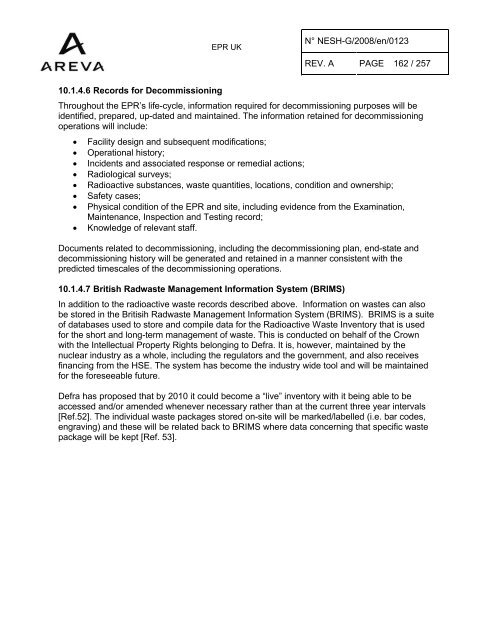Solid Radioactive Waste Strategy Report.pdf - UK EPR
Solid Radioactive Waste Strategy Report.pdf - UK EPR
Solid Radioactive Waste Strategy Report.pdf - UK EPR
You also want an ePaper? Increase the reach of your titles
YUMPU automatically turns print PDFs into web optimized ePapers that Google loves.
<strong>EPR</strong> <strong>UK</strong><br />
N° NESH-G/2008/en/0123<br />
REV. A PAGE 162 / 257<br />
10.1.4.6 Records for Decommissioning<br />
Throughout the <strong>EPR</strong>’s life-cycle, information required for decommissioning purposes will be<br />
identified, prepared, up-dated and maintained. The information retained for decommissioning<br />
operations will include:<br />
· Facility design and subsequent modifications;<br />
· Operational history;<br />
· Incidents and associated response or remedial actions;<br />
· Radiological surveys;<br />
· <strong>Radioactive</strong> substances, waste quantities, locations, condition and ownership;<br />
· Safety cases;<br />
· Physical condition of the <strong>EPR</strong> and site, including evidence from the Examination,<br />
Maintenance, Inspection and Testing record;<br />
· Knowledge of relevant staff.<br />
Documents related to decommissioning, including the decommissioning plan, end-state and<br />
decommissioning history will be generated and retained in a manner consistent with the<br />
predicted timescales of the decommissioning operations.<br />
10.1.4.7 British Radwaste Management Information System (BRIMS)<br />
In addition to the radioactive waste records described above. Information on wastes can also<br />
be stored in the Britisih Radwaste Management Information System (BRIMS). BRIMS is a suite<br />
of databases used to store and compile data for the <strong>Radioactive</strong> <strong>Waste</strong> Inventory that is used<br />
for the short and long-term management of waste. This is conducted on behalf of the Crown<br />
with the Intellectual Property Rights belonging to Defra. It is, however, maintained by the<br />
nuclear industry as a whole, including the regulators and the government, and also receives<br />
financing from the HSE. The system has become the industry wide tool and will be maintained<br />
for the foreseeable future.<br />
Defra has proposed that by 2010 it could become a “live” inventory with it being able to be<br />
accessed and/or amended whenever necessary rather than at the current three year intervals<br />
[Ref.52]. The individual waste packages stored on-site will be marked/labelled (i.e. bar codes,<br />
engraving) and these will be related back to BRIMS where data concerning that specific waste<br />
package will be kept [Ref. 53].

















